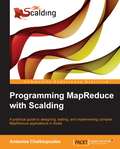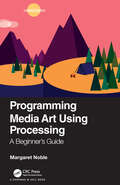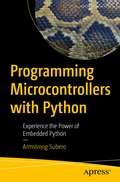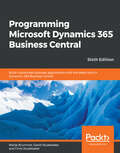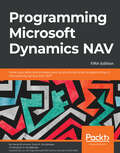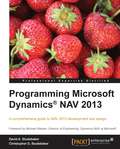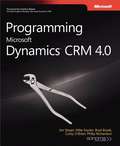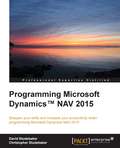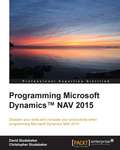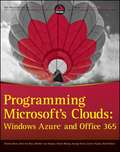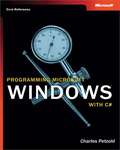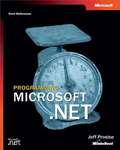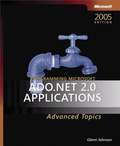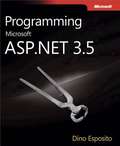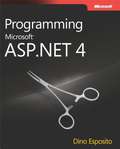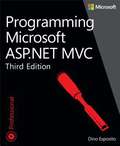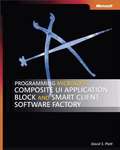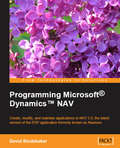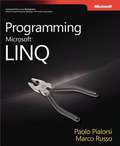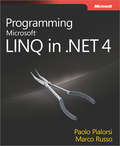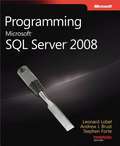- Table View
- List View
Programming MapReduce with Scalding
by Antonios ChalkiopoulosThis book is an easy-to-understand, practical guide to designing, testing, and implementing complex MapReduce applications in Scala using the Scalding framework. It is packed with examples featuring log-processing, ad-targeting, and machine learning. This book is for developers who are willing to discover how to effectively develop MapReduce applications. Prior knowledge of Hadoop or Scala is not required; however, investing some time on those topics would certainly be beneficial.
Programming Media Art Using Processing: A Beginner's Guide
by Margaret NobleProgramming Media Art Using Processing: A Beginner's Guide provides an entry-level exploration into visual design through computer programming using the open source and artist-friendly language, Processing. Used by hundreds of students, this learning system breaks lessons down into strategic steps towards fun and creative media art projects. This book provides a linear series of lessons with step-by-step examples that lead to beginning media art projects, including abstract designs, pixel landscapes, rollover animations, and simple video games. Computer programming can be overwhelming for the first-time learner, but this book makes the learning of code more digestible and fun through a full color, well-diagrammed, and deeply explained text presentation. Lessons are rhythmically broken down into digestible parts with code annotations and illustrations that help learners focus on the details one step at a time. The content is legible, flexible, and fun to work with because of its project-based nature. By following the lessons and producing the projects sequentially in this book, readers will develop the beginning foundational skills needed to understand computer programming basics across many languages and also explore the art of graphic design. Ultimately, this is a hands-on, practical guide.
Programming Microcontrollers with Python: Experience the Power of Embedded Python
by Armstrong SuberoFor the first time microcontrollers are powerful enough to be programmed in Python. The landscape of embedded systems development is changing, microcontrollers are becoming more powerful, and the rise of the internet of things is leading more developers to get into hardware. This book provides the solid foundation to start your journey of embedded systems development and microcontroller programming with Python. You’ll quickly realize the value of using Python. The theme of the book is simplicity and the cleanness and elegance of Python makes that possible. Featuring a step-by-step approach, this single source guide balances complexity and clarity with insightful explanations that you’ll easily grasp. Python is quickly becoming the language of choice for applications such as machine learning and computer vision on embedded devices. What would previously be daunting and exceedingly difficult to do in C or C++ is now possible with Python because of its level of abstraction. Programming Microcontrollers with Python is your path to bringing your existing skills to the embedded space. What You’ll Learn Review microcontroller basics and the hardware and software requirements Understand an embedded system’s general architectureFollow the steps needed to carry a product to market Take a crash course in Python programming Program a microcontrollerInterface with a microcontroller using LCD and Circuit PythonUse and control sensors Who This Book Is For Those getting started with microcontrollers, those new to C, C++, and Arduino programming, web developers looking to get into IoT, or Python programmers who wish to control hardware devices.
Programming Microsoft Dynamics 365 Business Central: Build customized business applications with the latest tools in Dynamics 365 Business Central, 6th Edition
by David Studebaker Mark Brummel Chris StudebakerExplore the fundamentals of Dynamics 365 Business Central and the Visual Studio Code development environment with the help of useful examples and case studiesKey FeaturesTailor your applications to best suit the needs of your businessExplore the latest features of Business Central with examples curated by industry expertsIntegrate Business Central features in your applications with this comprehensive guideBook DescriptionMicrosoft Dynamics 365 Business Central is a full ERP business solution suite with a robust set of development tools to support customization and enhancement. These tools can be used to tailor Business Central's in-built applications to support complete management functions for finance, supply chain, manufacturing, and operations.Using a case study approach, this book will introduce you to Dynamics 365 Business Central and Visual Studio Code development tools to help you become a productive Business Central developer. You'll also learn how to evaluate a product's development capabilities and manage Business Central-based development and implementation. You'll explore application structure, the construction of and uses for each object type, and how it all fits together to build apps that meet special business requirements.By the end of this book, you'll understand how to design and develop high-quality software using the Visual Studio Code development environment, the AL language paired with the improved editor, patterns, and features.What you will learnProgramming using the AL language in the Visual Studio Code development environmentExplore functional design and development using ALHow to build interactive pages and learn how to extract data for usersHow to use best practices to design and develop modifications for new functionality integrated with the standard Business Central softwareBecome familiar with deploying the broad range of components available in a Business Central systemCreate robust, viable systems to address specific business requirementsWho this book is forIf you want to learn about Dynamics 365 Business Central's powerful and extensive built-in development capabilities, this is the book for you. ERP consultants and managers of Business Central development will also find this book helpful. Although you aren't expected to have worked with Dynamics Business Central, basic understanding of programming and familiarity with business application software will help you understand the concepts covered in this book.
Programming Microsoft Dynamics NAV - Fifth Edition: Hone your skills and increase your productivity when programming in Microsoft Dynamics NAV 2017, 5th Edition
by Mark Brummel Christopher D. Studebaker David A. StudebakerCustomize your NAV applications About This Book • Gain from the insights and methods of industry-leading experts and tailor your applications to best suit the needs of your business • Learn through the detailed explanations and useful examples that are presented in a logical, step-by-step manner • This comprehensive guide is written with the goals of being used as a classroom text, a self-study text, and as a handy in-depth reference guide Who This Book Is For This book will appeal to all those who want to learn about NAV's powerful and extensive built-in development capabilities. It assumes that you understand programming and are familiar with business application software, although you aren't expected to have worked with NAV before. ERP consultants and managers of NAV development will also find the book helpful. What You Will Learn • Productively and effectively use the development tools that are built into Dynamics NAV • Understand the strengths of NAV's development tools and how they can be applied to address functional business requirements • Introduction to programming using the C/AL language in the C/SIDE Development Environment • Explore functional design and development using C/AL • Leverage advanced NAV development features and tools • Get to know the best practices to design and develop modifications of new functionality integrated with the standard NAV software In Detail Microsoft Dynamics NAV is a full business solution suite, and a complete ERP solution, which contains a robust set of development tools to support customization and enhancement. These tools help in greater control over financials and can simplify supply chain, manufacturing, and operations. This book will take you from an introduction to Dynamics NAV and its integrated development tools to being a productive developer in the Dynamics NAV Development Environment. You will find this book very useful if you want to evaluate the product's development capabilities or need to manage Dynamics NAV based projects. It will teach you about the NAV application structure, the C/SIDE development environment, the C/AL language paired with the improved editor, the construction and uses of each object type, and how it all fits together to build universal applications. With this new edition, you will be able to understand how to design and develop using Patterns and new features such as Extensions and Events. Style and approach This book is filled with examples and will serve as a comprehensive reference guide, complementing NAV's Help files.
Programming Microsoft Dynamics NAV 2009
by David StudebakerThis book takes you through the important topics of Microsoft Dynamics NAV with clear explanations and practical example code. There is also a substantial amount of reference material, which has been brought together in one place for you. This book takes care of what the working developer needs to know in order to become productive as quickly as possible. This book is for NAV consultants and developers, and developers or designers of business applications. Managers of NAV development or consultants will also find the book a helpful introduction to understanding NAV development capabilities. Any previous experience with NAV is not expected. Some basic knowledge of object-oriented programming will be quite helpful.
Programming Microsoft Dynamics NAV 2013
by Christopher D. Studebaker David A. StudebakerWritten as a practical guide, this book will show you how to utilize Dynamics NAV 2013 to its full potential. Designed to be a comprehensive reference, it should be the perfect companion for any NAV developer, manager or consultant. This book is for experienced programmers who are either new to Microsoft Dynamics NAV or for experienced developers that want to utilize the fantastic new features of NAV 2013. Managers and consultants will also benefit from understanding NAV environments in order to build on their skills and experience during development projects.
Programming Microsoft Dynamics® CRM 4.0
by Mike Snyder Jim Steger Brad Bosak Corey O'Brien Phil RichardsonGet answers to common questions about setting up the design environment and building custom solutions with Microsoft Dynamics CRM. Delve into core architecture, tools, and techniques, and learn how to exploit powerful customization features. Authored by industry-leading experts, this book shows how to deliver intelligent CRM solutions that meet the unique challenges and requirements of your business. Discover how to: Set up the development environment Enhance the product's APIs with your own code Execute business logic using plug-ins Build custom workflows that extend native workflow functions Create user-friendly integration with scripts and application extensions Code custom pages optimized for Microsoft Outlook with Offline Access Extend Microsoft Dynamics CRM using ASP.NET Create advanced Windows Workflow Foundation solutions Extend multilingual and multicurrency features Construct a custom security-access solution Get code samples on the Web.
Programming Microsoft Dynamics™ NAV 2015
by David Studebaker Christopher StudebakerThis book is targeted at those who want to learn NAV's powerful and extensive built-in development capabilities. It assumes that you understand programming and are familiar with business application software.
Programming Microsoft Dynamics™ NAV 2015
by David Studebaker Christopher StudebakerWritten as a practical guide, this book will show you how to utilize Dynamics NAV 2013 to its full potential. Designed to be a comprehensive reference, it should be the perfect companion for any NAV developer, manager or consultant. This book is for experienced programmers who are either new to Microsoft Dynamics NAV or for experienced developers that want to utilize the fantastic new features of NAV 2013. Managers and consultants will also benefit from understanding NAV environments in order to build on their skills and experience during development projects.
Programming Microsoft's Clouds
by Thomas Rizzo David Mann Darrin Bishop Razi Bin Rais George Durzi Zoiner Tejada Michiel Van OtegemA detailed look at a diverse set of Cloud topics, particularly Azure and Office 365More and more companies are realizing the power and potential of Cloud computing as a viable way to save energy and money. This valuable book offers an in-depth look at a wide range of Cloud topics unlike any other book on the market. Examining how Cloud services allows users to pay as they go for exactly what they use, this guide explains how companies can easily scale their Cloud use up and down to fit their business requirements. After an introduction to Cloud computing, you'll discover how to prepare your environment for the Cloud and learn all about Office 365 and Azure.Examines a diverse range of Cloud topics, with special emphasis placed on how Cloud computing can save businesses energy and moneyShows you how to prepare your environment for the CloudAddresses Office 365, including infrastructure services, SharePoint 2010 online, SharePoint online development, Exchange online development, and Lync online developmentDiscusses working with Azure, including setting it up, leveraging Blob storage, building Azure applications, programming, and debuggingOffers advice for deciding when to use Azure and when to use Office 365 and looks at hybrid solutions between Azure and Office 365Tap into the potential of Azure and Office 365 with this helpful resource.
Programming Microsoft® Windows® CE .NET
by Douglas BolingDesign sleek, high-performance applications for the newest smart mobile devices with the industry's most respected reference to Windows CE .NET. Now in its third edition, this essential guide has been updated for Windows CE .NET 4.2 and the .NET Compact Framework. Author Douglas Boling expertly demonstrates how to apply your Windows or embedded programming experience to the Windows CE .NET environment to build fast, small-footprint applications for the Windows Powered Pocket PC, Smartphone, and other next-generation devices. Accelerate your expertise--and get to market faster--with Doug's professional-level instruction and source code, including source code and tools on the CD and the Web. Learn how to: Use specialized techniques for handling memory, storage, and power constraints Enable communications to networks, PCs, or other devices--including using infrared and Bluetooth technologies NEW--Use the .NET Compact Framework to build CPU-independent applications Develop applications for the Pocket PC and create custom extensions NEW--Program for the unique requirements of the Smartphone, including security NEW--Use Short Message Service (SMS) to write connected applications on the Pocket PC Phone Edition and Smartphone NEW--Write your own device drivers, services, and super services Configure user and event notifications Program the Game API (GAPI)CD inside Includes source code and compiler plus links to SDKs and toolsCD features Source code for all the examples inside the book Embedded C++ Compiler Links to Windows CE .NET SDK, evaluation software, and other resources Fully searchable eBook A Note Regarding the CD or DVD The print version of this book ships with a CD or DVD. For those customers purchasing one of the digital formats in which this book is available, we are pleased to offer the CD/DVD content as a free download via O'Reilly Media's Digital Distribution services. To download this content, please visit O'Reilly's web site, search for the title of this book to find its catalog page, and click on the link below the cover image (Examples, Companion Content, or Practice Files). Note that while we provide as much of the media content as we are able via free download, we are sometimes limited by licensing restrictions. Please direct any questions or concerns to booktech@oreilly.com.
Programming Microsoft® Windows® with C#
by Charles Petzold"Look it up in Petzold" remains the last word on Windows development. In this .NET-ready Windows programming guide, the best-selling author shows you how to get the most out of Windows Forms--the next-generation Windows programming class library. You'll discover how to use C# to create dynamic user interfaces and graphical outputs for Windows applications. With dozens of examples of client applications to illustrate common techniques and plenty of no-nonsense advice on best programming practices, you'll be C# sharp in no time. Topics covered in this guide include: A tour of C# Windows Forms Essential structures An exercise in text output Lines, curves, and area fills Tapping into the keyboard Pages and transforms Taming the mouse Text and fonts The timer and time Images and bitmaps Buttons, labels, and scrolls Béziers and other splines Menus Paths, regions, and clipping Dialog boxes Brushes and pens Edit, list, and spin controls Font fun Toolbars and status bars Printing Tree view and List view Metafiles Clip, drag, and drop INCLUDED ON CD-ROM: * Sample source code for all the examples presented in the book A Note Regarding the CD or DVD The print version of this book ships with a CD or DVD. For those customers purchasing one of the digital formats in which this book is available, we are pleased to offer the CD/DVD content as a free download via O'Reilly Media's Digital Distribution services. To download this content, please visit O'Reilly's web site, search for the title of this book to find its catalog page, and click on the link below the cover image (Examples, Companion Content, or Practice Files). Note that while we provide as much of the media content as we are able via free download, we are sometimes limited by licensing restrictions. Please direct any questions or concerns to booktech@oreilly.com.
Programming Microsoft® .NET
by Jeff ProsiseThe Microsoft .NET initiative builds on industry standards to make interoperable software services available anywhere, on any device, over the Internet. Behind the initiative is the Microsoft .NET Framework, which combines a managed run-time environment with one of the richest class libraries ever invented to make building and deploying Web-enabled applications easier than ever. Find out how to leverage the full power of the .NET Framework with this definitive, one-stop resource, wri tten by a leading authority in his trademark easy-to-follow, conversational style. You'll learn about the key programming models embodied in the .NET Framework, including Windows® Forms, Web Forms, and XML Web services. And you'll benefit from a wealth of how-to examples, code samples, and complete working programs in C#. Topics covered in this guide include: Hello, .NET Types and Exceptions The .NET Framework Class Library Windows Forms Web Forms Web Controls User Controls Custom Controls Web Applications Microsoft ASP.NET Security XML Web Services Microsoft ADO.NET XML Multithreading Remoting CD-ROM FEATURES: A fully searchable electronic version of the book Source code for more than 60 complete sample programs and components written in C# The Microsoft .NET Framework SDK, plus Service Pack 1 A Note Regarding the CD or DVD The print version of this book ships with a CD or DVD. For those customers purchasing one of the digital formats in which this book is available, we are pleased to offer the CD/DVD content as a free download via O'Reilly Media's Digital Distribution services. To download this content, please visit O'Reilly's web site, search for the title of this book to find its catalog page, and click on the link below the cover image (Examples, Companion Content, or Practice Files). Note that while we provide as much of the media content as we are able via free download, we are sometimes limited by licensing restrictions. Please direct any questions or concerns to booktech@oreilly.com.
Programming Microsoft® ADO.NET 2.0 Applications: Advanced Topics
by Glenn JohnsonDive in for reference where you need it--and learn the intricacies of developing sleeker, more robust, security-enhanced applications in ADO.NET 2.0. Featuring code samples in Microsoft Visual C# and Visual Basic, this reference goes beyond the fundamentals to help professional developers solve sophisticated enterprise development problems. Discover how to: Examine advanced connectivity options and best practices--including connection pooling, clustered connections, and asynchronous access Use tracing to diagnose application flow and performance issues Resolve concurrency conflicts and implement a data access layer Implement seamless application failover from one Microsoft SQL Server database to another Use managed code and the SQLCLR to create stored procedures, user-defined functions and types, aggregates, and triggers Write effective data-caching code to improve application performance Use the Systems.Transactions namespace to work with Microsoft SQL Server 2005 Implement streaming techniques to "chunk" data Apply various methods to extract and modify XML data PLUS--Get code samples on the Web
Programming Microsoft® ADO.NET 2.0 Core Reference
by David SceppaBuild your expertise as you move beyond the basics--and delve into the essential topics of programming with ADO.NET 2.0. This comprehensive reference offers expert guidance, hands-on instruction, and code samples in Microsoft Visual C# and Visual Basic to help advance your mastery of developing database applications for Microsoft Windows and the Web. Discover how to: Work with design-time data access features in Microsoft Visual Studio 2005 Use Microsoft .NET Framework 2.0 data providers to connect to databases Build connection strings and enable connection pooling Execute queries, including parameterized and asynchronous queries, and retrieve their results Create DataSet objects to work with offline data and explore common usage scenarios Use the new Common Language Runtime features and XML data type in Microsoft SQL Server 2005 Generate logic and use stored procedures for simple to advanced updating scenarios Design Web applications with new data access features in ASP.NET 2.0--including code-free data-binding capabilities PLUS--Get Visual Basic and C# code samples, and a Microsoft .NET Data Provider on the Web
Programming Microsoft® ASP.NET 2.0 Core Reference
by Dino EspositoBuild your expertise as you move beyond the basics--and delve into the core topics of programming with ASP.NET 2.0. Useful to both experienced developers and those developing new skills, this ultimate reference is packed with expert guidance, hands-on programming instruction, and practical examples to help you advance your mastery of developing applications for the Web. Discover how to: Author rich, visually consistent pages and manage layout with themes and Master pages Create personalized pages that persist user preferences Retrieve, modify, and manage data with Microsoft ADO.NET Configure the HTTP pipeline to serve ASP.NET 2.0 pages Control program flow by tracing and handling exceptions Design caching layers and learn state management techniques to optimize application performance Manage users with membership control, registration, and authentication capabilities Build real-world data access layers using common design patterns Use custom collections with data source controls Learn the internals of grid controls PLUS--Get code samples on the Web
Programming Microsoft® ASP.NET 3.5
by Dino EspositoGet the practical, popular reference written by ASP.NET authority Dino Esposito--now updated for ASP.NET 3.5. An in-depth guide to the core features of Web development with ASP.NET, this book goes beyond the fundamentals. It expertly illustrates the intricacies and uses of ASP.NET 3.5--in a single volume. Part of Microsoft Visual Studio® 2008, ASP.NET 3.5 includes AJAX functionality, the Microsoft SilverlightTM cross-platform development tool, new controls, and new integration features. This pragmatic guide covers these new features, and also includes coverage of Windows® Communication Foundation, LINQ, and other key Microsoft .NET Framework 2.0, 3.0, and 3.5 capabilities. Complete with extensive code samples and code snippets in Microsoft Visual C# 2008, this is the ideal reference for developers who want to learn what's new in ASP.NET 3.5, or for those building professional-level Web development skills.
Programming Microsoft® ASP.NET 4
by Dino EspositoCompletely reengineered for ASP.NET 4--this definitive guide deftly illuminates the core architecture and programming features of ASP.NET 4 in a single, pragmatic volume. Web development expert Dino Esposito provides essential, architectural-level guidance, along with the in-depth technical insights designed to take you--and your solutions--to the next level. The book covers Dynamic Data, AJAX, Microsoft Silverlight®, ASP.NET MVC, Web forms, LINQ, and security strategies--and features extensive code samples in Microsoft Visual C#® 2010.
Programming Microsoft® ASP.NET MVC
by Dino EspositoFully updated for ASP.NET MVC 3. Delve into the features, principles, and pillars of the ASP.NET MVC framework--deftly guided by web development luminary Dino Esposito. ASP.NET MVC forces developers to think in terms of distinct components--Model, View, Controller--that make it easier to manage application complexity, while allowing strict control over the markup. Plunge into the framework's internal mechanics and gain perspectives on how to use this programming model versus Web Forms, and begin building your own MVC-based applications quickly.
Programming Microsoft® Composite UI Application Block and Smart Client Software Factory
by David S. PlattGet practical, hands-on instruction for learning the Composite UI Application Block (CAB) and the Smart Client Software Factory. Using just your fundamental Microsoft Visual Basic or Visual C# skills, you'll work through seven lessons that present real-world scenarios. Each lesson is based on proven classroom guidance--building the skills your need to easily create user interface components for smart-client solutions. Discover how to: Generate a shell application and implement prefabricated or custom CAB services Use work items and controllers to share resources in loosely coupled applications Optimize visual information display by using Workspaces and SmartParts Add and modify menus, toolbars, and status bars by using the CAB user interface extension Announce and receive asynchronous events within an application Invoke methods in the Action Catalog service to coordinate application business-logic Match CAB constructs to Windows Presentation Foundation
Programming Microsoft® Dynamics™ NAV
by David StudebakerFast-paced and to-the-point, this book takes you through the important topics of Microsoft Dynamics NAV with clear explanations and practical example code. The book's selection of topics is driven by what the working developer needs to know in order to become productive as quickly as possible. The business applications software designer/developer who: Wants to become productive in NAV C/SIDE C/AL development as quickly as possible Understands business applications and the associated software Has significant programming experience Has access to NAV including at least the Designer granules, preferably a full development license and a standard Cronus demo database Is willing to do the exercises to get hands-on experience The Reseller manager or executive who wants a concise, in depth view of NAVs development environment and tool set The technically knowledgeable manager or executive of a firm using NAV that is about to embark on a significant NAV enhancement project The technically knowledgeable manager or executive of a firm considering purchase of NAV as a highly customizable business applications platform The reader of this book: Does not need to be expert in object-oriented programming Does not need to have previous experience with NAV
Programming Microsoft® LINQ
by Marco Russo Paolo PialorsiGet comprehensive guidance for using the Microsoft Language Integrated Query (LINQ) Project--with in-depth insights from two experienced developers. Data-rich applications can be difficult to create because of the tremendous differences between query languages used to access data and the programming languages commonly used to write applications. This practical guide covers the intricacies of LINQ, a set of extensions to the Visual C# and Visual Basic programming languages. Instead of traversing different language syntaxes required for accessing data from relational and hierarchical data sources, developers will learn how to write queries natively in Visual C# or Visual Basic--helping reduce complexity and boost productivity. Written by two experienced developers with strong ties to the developer teams at Microsoft, this book describes the LINQ architecture and classes, details the new language features in both Visual C# and Visual Basic, and provides code samples in both languages.
Programming Microsoft® LINQ in Microsoft .NET Framework 4
by Marco Russo Paolo PialorsiDig into LINQ -- and transform the way you work with data. With LINQ, you can query data from a variety of sources -- including databases, objects, and XML files -- directly from Microsoft Visual Basic® or C#. Guided by data-access experts who've worked in depth with LINQ and the Microsoft development teams, you'll learn how .NET Framework 4 implements LINQ, and how to exploit it. Clear examples show you how to deliver your own data-access solutions faster and with leaner code. Discover how to: Use LINQ to query databases, object collections, arrays, XML, Microsoft Excel® files, and other sources Apply LINQ best practices to build data-enabled .NET applications and services Manipulate data in a relational database with ADO.NET Entity Framework or LINQ to SQL Read, write, and manage XML content more efficiently with LINQ to XML Extend LINQ to support additional data sources by creating custom operators and providers Examine other implementations, such as LINQ to SharePoint® Use LINQ within the data, business, and service layers of a distributed application Get code samples on the Web
Programming Microsoft® SQL Server® 2008
by Andrew Brust Leonard Lobel Stephen ForteExtend your programming skills with a comprehensive study of the key features of SQL Server 2008. Delve into the new core capabilities, get practical guidance from expert developers, and put their code samples to work. This is a must-read for Microsoft .NET and SQL Server developers who work with data access--at the database, business logic, or presentation levels. Discover how to: Query complex data with powerful Transact-SQL enhancements Use new, non-relational features: hierarchical tables, native file streaming, and geospatial capabilities Exploit XML inside the database to design XML-aware applications Consume and deliver your data using Microsoft LINQ, Entity Framework, and data binding Implement database-level encryption and server auditing Build and maintain data warehouses Use Microsoft Excel to build front ends for OLAP cubes, and MDX to query them Integrate data mining into applications quickly and effectively Get code samples on the Web.
